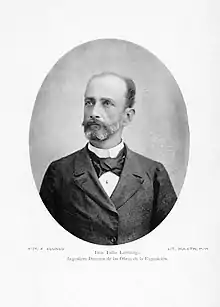Tulio Larrínaga
Tulio Larrínaga (January 15, 1847 – April 28, 1917) was a Resident Commissioner of Puerto Rico.
Tulio Larrínaga | |
|---|---|
 | |
| Resident Commissioner of Puerto Rico | |
| In office March 4, 1905 – March 3, 1911 | |
| Preceded by | Federico Degetau |
| Succeeded by | Luis Muñoz Rivera |
| Personal details | |
| Born | January 15, 1847 Trujillo Alto, Puerto Rico |
| Died | April 28, 1917 (aged 70) San Juan, Puerto Rico |
| Political party | Unionist |
| Education | Rensselaer Polytechnic Institute University of Pennsylvania (BS) |
Biography
Born in Trujillo Alto, Puerto Rico, Larrínaga attended the Seminario Consiliar of San Ildefonso at San Juan, Puerto Rico. He studied civil engineering at the Rensselaer Polytechnic Institute in Troy, New York, and, in 1871, graduated from the University of Pennsylvania in Philadelphia.
Larrínaga practiced his profession in the United States for some time, returning to Puerto Rico in 1872 where he was appointed architect for the city of San Juan. In 1880, Larrínaga built the first railroad in Puerto Rico and introduced American rolling stock onto the island. For ten years he was the chief engineer of the Provincial Works.
Larrínaga's involvement in politics began in 1898, when he was appointed Assistant Secretary of the Interior in the Autonomist government. Two years later, he was sent by his party as a delegate to Washington, D.C.
Larrínaga served as member of the house of delegates for the district of Arecibo in 1902. In 1904, he was elected as a Unionist Resident Commissioner to the United States. He was reelected twice, serving from March 4, 1905, until March 3, 1911. Larrínaga also served as delegate from the United States to the Third Pan-American Conference held in Rio de Janeiro in 1906. In 1911, he served as a member of the executive council of Puerto Rico.
Following his political career, Larrínaga resumed the practice of civil engineering in San Juan. He died there on April 28, 1917, and was interred at Cementerio Municipal de Mayagüez in Mayagüez, Puerto Rico.[1]
References
Sources
- United States Congress. "Tulio Larrínaga (id: L000102)". Biographical Directory of the United States Congress.
![]() This article incorporates public domain material from the Biographical Directory of the United States Congress.
This article incorporates public domain material from the Biographical Directory of the United States Congress.